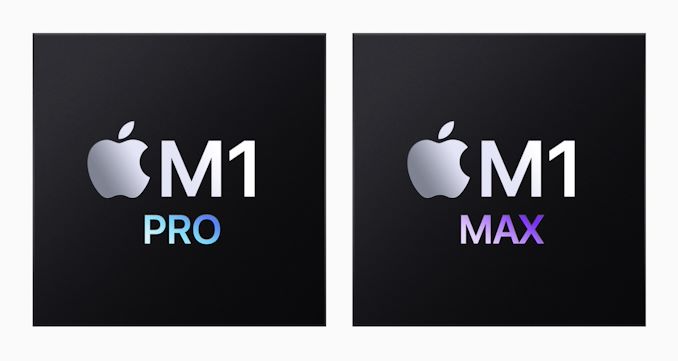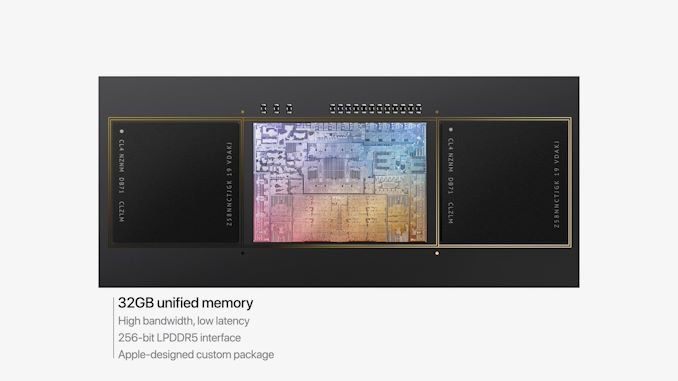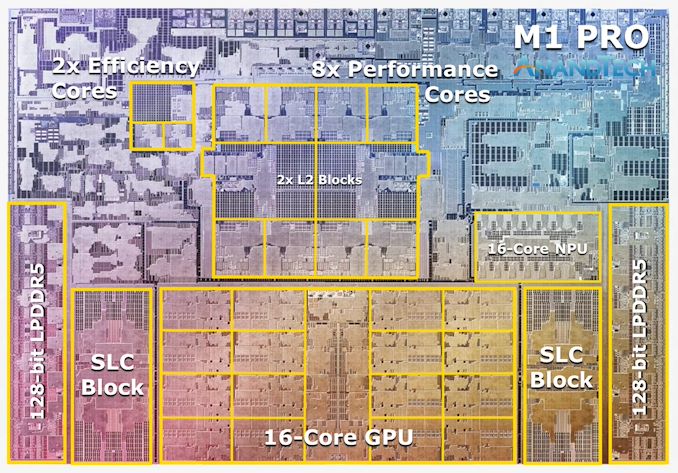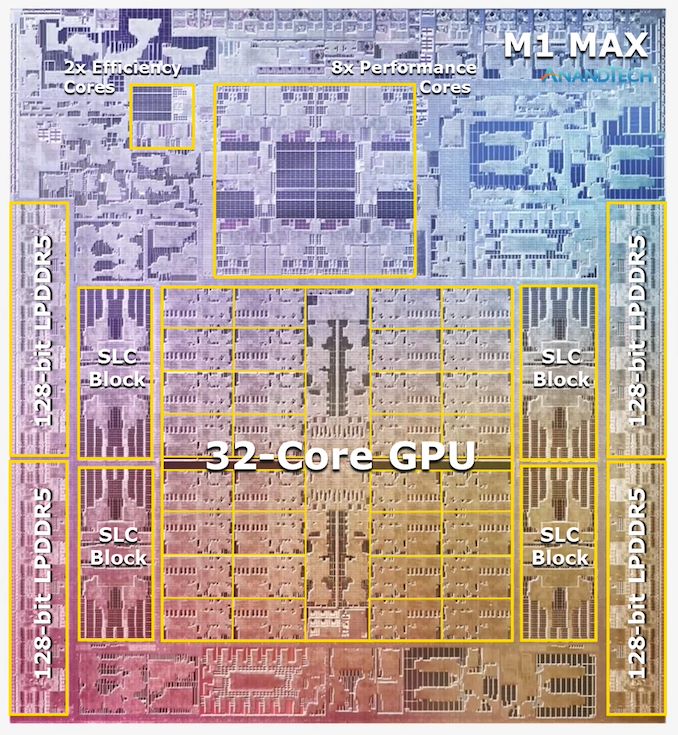Apple's M1 Pro, M1 Max SoCs Investigated: New Performance and Efficiency Heights
by Andrei Frumusanu on October 25, 2021 9:00 AM EST- Posted in
- Laptops
- Apple
- MacBook
- Apple M1 Pro
- Apple M1 Max

Last week, Apple had unveiled their new generation MacBook Pro laptop series, a new range of flagship devices that bring with them significant updates to the company’s professional and power-user oriented user-base. The new devices particularly differentiate themselves in that they’re now powered by two new additional entries in Apple’s own silicon line-up, the M1 Pro and the M1 Max. We’ve covered the initial reveal in last week’s overview article of the two new chips, and today we’re getting the first glimpses of the performance we’re expected to see off the new silicon.
The M1 Pro: 10-core CPU, 16-core GPU, 33.7bn Transistors
Starting off with the M1 Pro, the smaller sibling of the two, the design appears to be a new implementation of the first generation M1 chip, but this time designed from the ground up to scale up larger and to more performance. The M1 Pro in our view is the more interesting of the two designs, as it offers mostly everything that power users will deem generationally important in terms of upgrades.
At the heart of the SoC we find a new 10-core CPU setup, in a 8+2 configuration, with there being 8 performance Firestorm cores and 2 efficiency Icestorm cores. We had indicated in our initial coverage that it appears that Apple’s new M1 Pro and Max chips is using a similar, if not the same generation CPU IP as on the M1, rather than updating things to the newer generation cores that are being used in the A15. We seemingly can confirm this, as we’re seeing no apparent changes in the cores compared to what we’ve discovered on the M1 chips.
The CPU cores clock up to 3228MHz peak, however vary in frequency depending on how many cores are active within a cluster, clocking down to 3132 at 2, and 3036 MHz at 3 and 4 cores active. I say “per cluster”, because the 8 performance cores in the M1 Pro and M1 Max are indeed consisting of two 4-core clusters, both with their own 12MB L2 caches, and each being able to clock their CPUs independently from each other, so it’s actually possible to have four active cores in one cluster at 3036MHz and one active core in the other cluster running at 3.23GHz.
The two E-cores in the system clock at up to 2064MHz, and as opposed to the M1, there’s only two of them this time around, however, Apple still gives them their full 4MB of L2 cache, same as on the M1 and A-derivative chips.
One large feature of both chips is their much-increased memory bandwidth and interfaces – the M1 Pro features 256-bit LPDDR5 memory at 6400MT/s speeds, corresponding to 204GB/s bandwidth. This is significantly higher than the M1 at 68GB/s, and also generally higher than competitor laptop platforms which still rely on 128-bit interfaces.
We’ve been able to identify the “SLC”, or system level cache as we call it, to be falling in at 24MB for the M1 Pro, and 48MB on the M1 Max, a bit smaller than what we initially speculated, but makes sense given the SRAM die area – representing a 50% increase over the per-block SLC on the M1.
The M1 Max: A 32-Core GPU Monstrosity at 57bn Transistors
Above the M1 Pro we have Apple’s second new M1 chip, the M1 Max. The M1 Max is essentially identical to the M1 Pro in terms of architecture and in many of its functional blocks – but what sets the Max apart is that Apple has equipped it with much larger GPU and media encode/decode complexes. Overall, Apple has doubled the number of GPU cores and media blocks, giving the M1 Max virtually twice the GPU and media performance.
The GPU and memory interfaces of the chip are by far the most differentiated aspects of the chip, instead of a 16-core GPU, Apple doubles things up to a 32-core unit. On the M1 Max which we tested for today, the GPU is running at up to 1296MHz - quite fast for what we consider mobile IP, but still significantly slower than what we’ve seen from the conventional PC and console space where GPUs now can run up to around 2.5GHz.
Apple also doubles up on the memory interfaces, using a whopping 512-bit wide LPDDR5 memory subsystem – unheard of in an SoC and even rare amongst historical discrete GPU designs. This gives the chip a massive 408GB/s of bandwidth – how this bandwidth is accessible to the various IP blocks on the chip is one of the things we’ll be investigating today.
The memory controller caches are at 48MB in this chip, allowing for theoretically amplified memory bandwidth for various SoC blocks as well as reducing off-chip DRAM traffic, thus also reducing power and energy usage of the chip.
Apple’s die shot of the M1 Max was a bit weird initially in that we weren’t sure if it actually represents physical reality – especially on the bottom part of the chip we had noted that there appears to be a doubled up NPU – something Apple doesn’t officially disclose. A doubled up media engine makes sense as that’s part of the features of the chip, however until we can get a third-party die shot to confirm that this is indeed how the chip looks like, we’ll refrain from speculating further in this regard.














493 Comments
View All Comments
darwinosx - Friday, November 5, 2021 - link
Everything you said is wrong.C@illou - Tuesday, October 26, 2021 - link
Slight correction, Vulkan works great on windows (and also works on Linux, but that counts the same as "SteamOS"), that makes it the most compatible API.xeridea - Tuesday, October 26, 2021 - link
Vulkan runs on everything.Qozmo - Tuesday, October 26, 2021 - link
Worth mentioning that MoltenVK exists officially from Khronos Group which layers Vulcan on top of the MetalAPI enabling Vulcan apps to run on MacOS/iOSWrs - Monday, October 25, 2021 - link
Is it just me or does that make no economic sense? When I’m AAA gaming (flashy visuals, complex scenes, high fps) I don’t feel as if I’m looking for light and cool or portable. I’d be on a desk flinging a mouse, or wielding a controller in front of a TV.michael2k - Monday, October 25, 2021 - link
Maybe it isn't clear, but 'light and cool' means there is lots of headroom for overclocking. From the third page:Power Behaviour: No Real TDP, but Wide Range
Apple doesn’t advertise any TDP for the chips of the devices – it’s our understanding that simply doesn’t exist, and the only limitation to the power draw of the chips and laptops are simply thermals. As long as temperature is kept in check, the silicon will not throttle or not limit itself in terms of power draw.
You can imagine that in a desktop, with far better cooling and far more available power, that the M1P/M1M might grow well beyond the 92W of observed package power. The Mac Pro with 28 cores and 2 GPUs today will allow the CPU to consume 902W, there is a lot of space for performance to grow!
So imagine 10x more performance from a desktop Mac with 10 M1P in some kind of fabric (100 cores and 320 GPUs!) or a much smaller number of M1P, maybe 4 (40 cores and 128 GPUs) with each allowed to consume 2.5x as much power
sean8102 - Tuesday, October 26, 2021 - link
Problem is developer support. It seems there are only 2 "AAA" macOS AND ARM native games.https://www.applegamingwiki.com/wiki/M1_native_com...
That has to improve A LOT for getting a ARM Mac for gaming to make any sense. Otherwise you're always taking the performance hit of Rosetta 2. Plus not many AAA games are releasing for macOS since they announced the switch to ARM.
The chips are amazing in terms of performance and efficiency, but getting a mac esp a ARM based one for gaming wouldn't make much sense. At least for now and not unless developer support improves A LOT.
AshlayW - Tuesday, October 26, 2021 - link
Clock speeds do not scale with power consumption and Firestorm cores are not designed to reach high clock speeds, these cores would likely not break 3.5 if overclocked (wide, dense design for perf/W). AMD / Intel / NVIDIA's 5nm-class processors will put Apple back in its place for people wanting to NOT be locked into a walled garden from a company adamant on crushing consumer rights. It's just a shame that Apple's silicon engineers are so freakin' good, they're working for the wrong company (and hurting human progress by putting the best wafers/chips in Apple products).valuearb - Tuesday, October 26, 2021 - link
Lol apple is responsible for more human progress than all the other PC makers combined.MooseNSquirrel - Friday, October 29, 2021 - link
Only if your metric is marketing based.